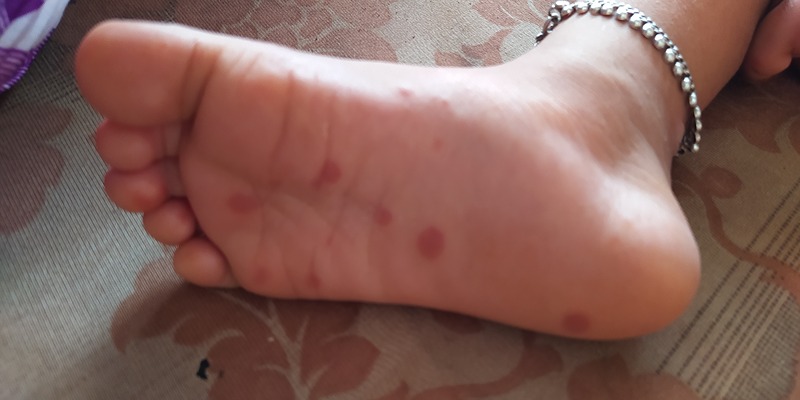Although it is more common in children, adults are not immune to the extremely infectious virus that causes this disease. You may also have a high temperature and a scratchy throat in addition to the sores in your mouth and rashes on your hands and feet that are classic signs of this illness. Because of the close quarters in which children congregate, the coxsackievirus is a frequent source of this illness, making it especially problematic in settings like schools and daycares. Understanding the causes, signs, and treatment of this often mild illness is essential for stopping its spread and speeding up the healing process.
Identifying the Disease
Recognizing the Symptoms
The symptoms tend to manifest in a certain order that may be used to pinpoint the disease. Fever and a sore throat are two of the first symptoms to appear, and they may easily be mistaken for the flu or a cold. However, painful sores in the mouth and a characteristic rash on the palms and soles of the feet often follow. Even while these symptoms are often modest, they may nevertheless be bothersome, especially for small children. Early detection of these symptoms may assist in the disease's diagnosis and treatment.
Disease Progression
Hand, Foot, and Mouth Disease often worsens over the course of a few days. Initial signs may include low fever and sore throat, similar to the flu. Small red patches that may later burst into painful sores occur in the mouth in the following days. Rashes that are not itchy appear on the hands and feet at around the same time. Although the virus is most dangerous during the first week, it may remain dormant in the body for weeks after the symptoms have subsided, making it imperative to exercise strict cleanliness in order to avoid the spread of the sickness.

Causes and Transmission
Viral Causes
Coxsackievirus A16, a kind of the Enterovirus family, is the most common cause of this disease. Humans are the primary hosts for this virus, and children are the most vulnerable. Infection begins when the virus enters the body, most often via the mouth or nose. It then multiplies, having a systemic effect on the organism. The disease's telltale rashes and sores in the mouth and on the hands and feet are caused by this virus's preference for those areas.
Modes of Transmission
Hand, Foot, and Mouth Disease (HFMD) is mostly spread via interpersonal contact. The infectious sickness spreads rapidly via the air when an infected individual sneezes or coughs. Contact with blister fluid or feces from an infected individual is another potential route of transmission. Moreover, the necessity of cleanliness in preventing the transmission of the illness is particularly relevant in situations where close contact between persons is widespread, such as childcare facilities and schools.
Hand Foot and Mouth Disease Treatment
Medical Interventions
Since the viruses that cause Hand, Foot, and Mouth Disease cannot be eliminated entirely, treatment focuses on relieving the disease's symptoms. Antipyretics, such as acetaminophen or ibuprofen, are often prescribed by doctors to lower fever and associated pain in patients undergoing medical treatment. Antiviral drugs may be used to treat problems in extreme circumstances. To effectively manage symptoms and avoid subsequent infections, it is essential to visit a healthcare practitioner for an accurate diagnosis and treatment recommendation, particularly in the case of severe symptoms or consequences.
At-Home Care and Remedies
Hand, Foot, and Mouth Disease recovery is greatly aided by home care for symptoms. Because the sores in the mouth may make swallowing difficult, it is essential to ensure that the afflicted person gets enough of fluids. Having something cold to drink, like a smoothie or an ice pop, may be really comforting. It's also important to keep up with your regular oral hygiene routine to avoid getting a secondary bacterial infection in your mouth sores. Rashes on the skin may be treated with aloe vera gel or coconut oil. In order to help the body fight off the illness, rest is also crucial. However, even while using home remedies, it is vital to follow medical guidance to guarantee safety and effectiveness.

Prevention Strategies
Hygiene Practices
Prevention of Hand, Foot, and Mouth Disease relies heavily on diligent attention to personal cleanliness. Washing your hands often and thoroughly with soap and water may greatly minimize the spread of disease. Before preparing or eating food, as well as after using the restroom or changing a baby's diaper, hand washing is essential. To reduce the transmission of the virus, it is important to clean and disinfect high-touch areas and items, such as toys and doorknobs. Reinforcing these preventive actions and creating a healthier atmosphere may be aided by teaching youngsters the value of basic cleanliness.
Isolation and Care of the Infected
To prevent the spread of Hand, Foot, and Mouth Disease, it is essential to quarantine affected patients, particularly young children. School or work should be avoided until the infected person is no longer infectious, often after the fever has dropped and the sores have healed. The infected person has to be properly cared for, including hydration, nourishment, and symptom treatment, while they are quarantined. Prevention of further spread and acceleration of the sick person's recovery are both possible outcomes of providing for them care and seclusion.
Conclusion
The extremely infectious nature of Hand, Foot, and Mouth Disease, which mostly affects children, presents considerable issues in close-knit institutions like schools and daycares. Early identification and treatment are greatly aided by a thorough familiarity with symptoms such as fever, sore throat, mouth sores, and skin rashes. Knowing the viral causes and mechanisms of transmission is crucial in order to prevent the spread of the disease and save lives. Although there is currently no known cure, it has been shown that a combination of preventative measures and treatment aimed at reducing symptoms has been effective in limiting outbreaks and facilitating speedy recoveries. Awareness, prompt treatment, and preventative measures all work together to counteract the effects of this pervasive illness.




